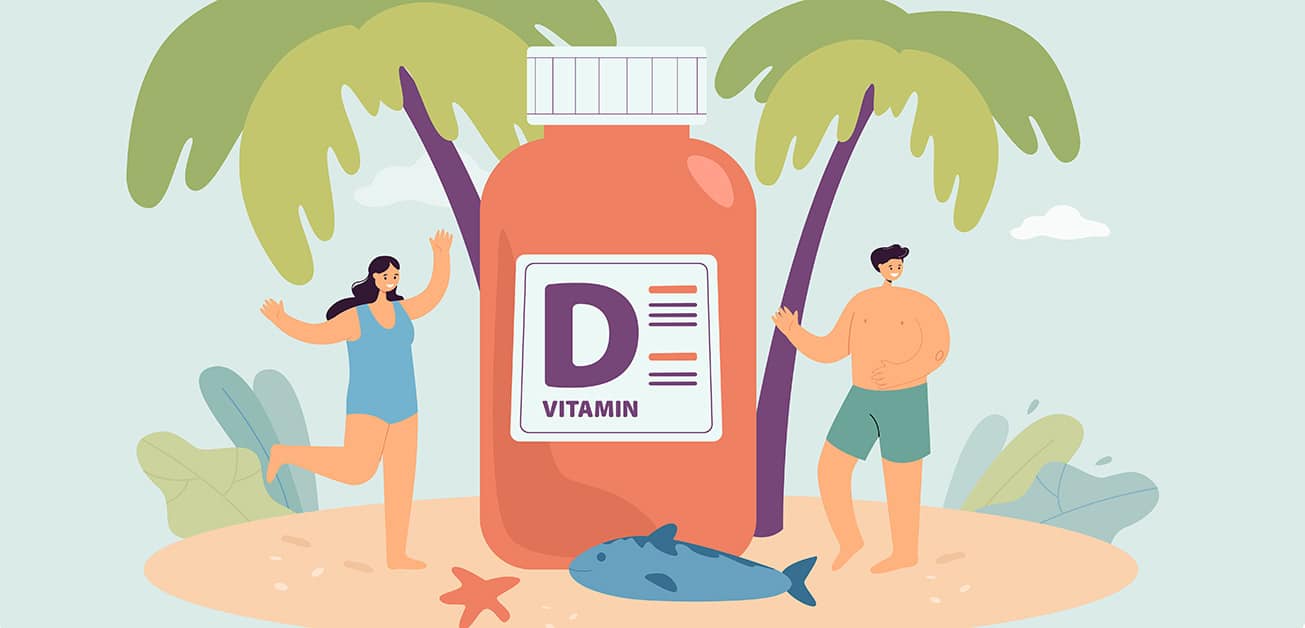VITAMIN D DEFICIENCY
5 main causes of Vitamin D deficiency
Our bodies are capable of making Vitamin D from sunlight which is vital in absorbing and retaining calcium, as well as phosphorus. These minerals are crucial when it comes to building strong bones. Albeit these minerals are abundant in our bodies, without the help of Vitamin D, our bones are unable to absorb these minerals – leading to a loss of bone density and increased susceptibility to bone diseases.1
Most people are unable to sustain their bodies by simply relying on it to create Vitamin D from the sun. This is due to multiple factors like skin colour, the amount of sunlight our skin is exposed to based on the clothes we wear, preference for being in the shade, geographical location, and even the amount of sunscreen we apply. All of these affect how our bodies absorb ultraviolet B rays (UVB) to create Vitamin D.2
To maintain a healthy level of Vitamin D in our bodies, some of us have to depend on a few external sources; the food we consume, or from supplements. Without these sources, our bodies may suffer from Vitamin D deficiency, leading to a multitude of bone and health issues ranging from osteoporosis, increased risk of fractures, diabetes, and even immune system disorders.3 To understand this better, let’s take a look at some of the main causes of Vitamin D deficiency.
Vitamin D Deficiency Causes⁴
1) Under consumption Vitamin D rich foods
There are only a few foods that are rich in Vitamin D such as fatty fish (like tuna and salmon), red meat, egg yolks, fortified milk and mushrooms. Additionally, in order to meet an adult’s daily needs, one has to eat a significant amount of such foods in a day.7 Having a diet that’s lacking in Vitamin D can lead to a deficiency.
2) Vitamin D Malabsorption
In some cases, the body is unable to absorb Vitamin D as well as others. The malabsorption of Vitamin D can be caused by various issues stemming from hereditary to medical issues like cystic fibrosis, celiac disease, and Crohn’s disease which affect the intestine’s ability to absorb Vitamin D.
3) Unable to synthesize Vitamin D from sunlight
Our body makes Vitamin D from cholesterol when our skin is exposed to sunlight. For this synthesis to occur, the sun’s ultraviolet B has to be able to penetrate into the epidermis. This may be an issue for individuals with darker skin as the melanin in the skin does not allow it to absorb as much ultraviolet B as needed.
4) Old age
Age could also be a factor that influences how our bodies convert Vitamin D into its active form for the body to use. As we age, our organs start to lose the ability to function fully. The kidneys are mainly responsible for converting Vitamin D into an active form that our body can use – as our kidney becomes less functional, our chances of Vitamin D deficiency increase.5
5) Medication
There are certain medications that can hinder the absorption of Vitamin D in our bodies. A doctor would be able to advise on the amount of medication and Vitamin D you may need to supplement your body.
Vitamin D Deficiency Symptoms
With all these causes in mind, what are some signs to look out for when it comes to Vitamin D deficiency? Early symptoms include6:
– Fatigue
– Aches in the bones and joints
– Muscle weakness and aches
– Mood swings
– Slow wound healing3
As these symptoms are common for a myriad of other issues, it is important to be properly diagnosed by a doctor. For Vitamin D deficiency, necessary tests will be administered by doctors to identify the necessary treatment.
How To Get Vitamin D
There are several ways to treat Vitamin D deficiency in Singapore. Depending on the levels of deficiency, a doctor may suggest diet changes for the least severe cases by increasing the consumption of foods that are rich in Vitamin D. Lifestyle changes are also recommended for individuals who are not exposed to sunlight often. This may include adopting a more active lifestyle outdoors so that the body can produce Vitamin D when exposed to sunlight.
At Sunshine Vitamin, our goal is to not only educate but to also provide trustworthy and efficient clinical grade Vitamin D products for individuals with Vitamin D deficiency. We carry Cholecalciferol in Singapore in different presentations including solutions and sprays. Our products can be consumed by both adults and children with the necessary dosage advised by our partner doctors.
For individuals looking for professional consultation and treatment on Vitamin D deficiency, do proceed to our partner clinics here or you can contact us directly.
References
1) Dowhan Hoag, L., Dharmarajan, T.S. (2021). Calcium and Phosphorus. In: Pitchumoni, C.S., Dharmarajan, T. (eds) Geriatric Gastroenterology. Springer, Cham. Available at:
https://doi.org/10.1007/978-3-030-30192-7_26.. Accessed 29 July 2022.
2) Sampson, Stacy, and Annie Lennon. “How to get the most vitamin D from the sun: Tips and other sources.” Available at:
https://www.medicalnewstoday.com/articles/326167#boosting-vitamin-d. Accessed 29 July 2022.
3) Wartenberg, Lisa, and Franziska Spritzler. “Vitamin D Deficiency: Symptoms, Treatments, and Causes.” Available at:
https://www.healthline.com/nutrition/vitamin-d-deficiency-symptoms#symptoms. Accessed 29 July 2022.
4) U.S. Department of Health and Human Services. “Vitamin D Deficiency.” Available at:
https://medlineplus.gov/vitaminddeficiency.html. Accessed 29 July 2022.
5) Institute on Aging. “Bone Deep: Why Vitamin D Is Essential for Older Adults – IOA Blog.” Blog, 31 August 2016. Available at:
https://blog.ioaging.org/caregiving/vitamin-d-essential-older-adults/. Accessed 29 July 2022.[JS3]
6) Cleveland Clinic. “Vitamin D Deficiency: Causes, Symptoms & Treatment.” Available at:
https://my.clevelandclinic.org/health/diseases/15050-vitamin-d-vitamin-d-deficiency. Accessed 29 July 2022.
7) National Institutes of Health. Vitamin D Fact Sheet for Health Professionals. Available at:
https://ods.od.nih.gov/factsheets/VitaminD-HealthProfessional. Accessed 30 June 2021.
RELATED ARTICLES









